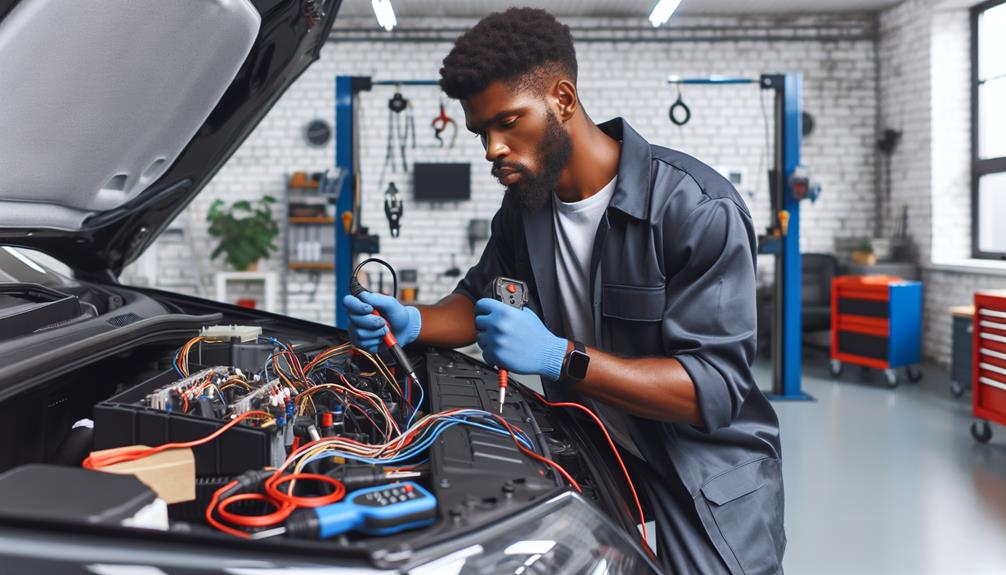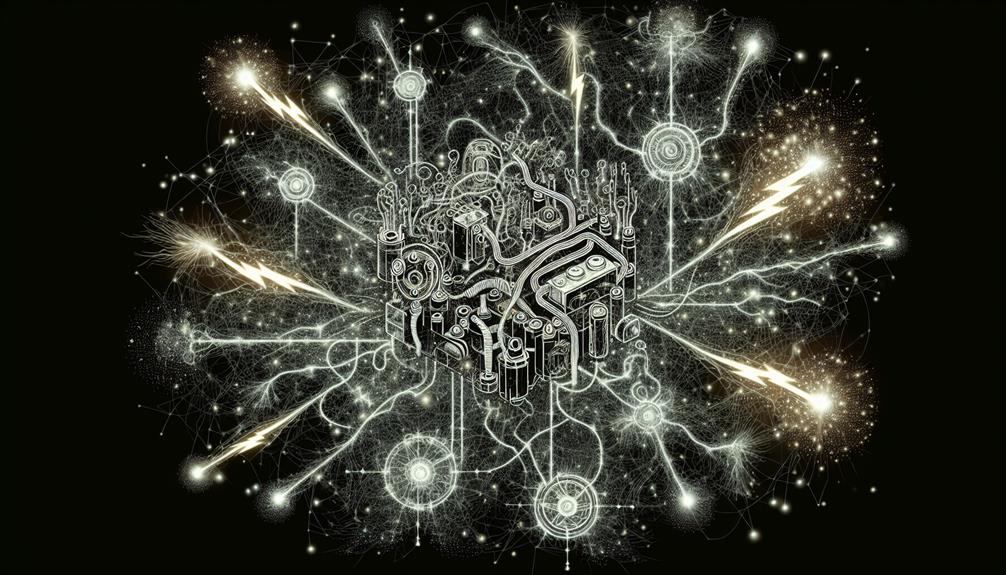Imagine your car's electrical system as the intricate wiring of a high-tech spaceship hurtling through space. Just like any complex machinery, it is bound to encounter some glitches along the way.
But fear not, for this comprehensive guide is here to help you navigate through the maze of common electrical problems in cars. From battery issues to faulty wiring, we will equip you with the knowledge and tools to tackle these challenges head-on.
So buckle up and get ready to unravel the mysteries of your car's electrical system, because a smooth and hassle-free ride awaits you.
Key Takeaways
- Regularly inspect and clean the battery terminals to prevent corrosion and ensure a secure connection.
- Troubleshoot starter problems by checking the ignition switch, wires, battery, and starter motor.
- Recognize signs of alternator failure such as a dead battery, dimming lights, and warning lights, and conduct a voltage test to confirm.
- Be aware of the potential dangers of faulty wiring, including blown fuses, melted wires, and electrical fires, and take necessary measures to repair or replace damaged wiring.
Battery Issues
If you're experiencing battery issues in your car, it's crucial to diagnose and resolve the problem promptly to ensure proper functioning of your vehicle's electrical system. Battery maintenance is essential for the longevity and efficiency of your car's battery. Regularly inspect the battery for signs of corrosion, such as white or blue-green deposits on the terminals. Clean the terminals with a mixture of baking soda and water to remove any buildup. Additionally, make sure the battery is securely fastened in its tray to prevent vibrations that can damage the connections.
When it comes to jump starting techniques, it's important to follow the correct procedure to avoid any damage to your vehicle or yourself. First, ensure the ignition is off and both cars are in neutral or park. Connect the positive (red) jumper cable to the positive terminal of the dead battery, and the other end to the positive terminal of the donor battery. Then, connect the negative (black) cable to the negative terminal of the donor battery, and the other end to a metal part of the car with the dead battery, away from the battery itself. Start the engine of the donor car and let it run for a few minutes, then try starting the dead car. Once it starts, remove the cables in the reverse order they were connected.
Starter Problems
Starter problems in cars can cause issues with the engine's ability to start and should be addressed promptly to ensure proper functioning of the electrical system. Ignition failure and engine cranking are common symptoms of starter problems. To help you diagnose and fix these issues, refer to the table below which outlines possible causes and solutions for starter problems:
| Problem | Possible Cause | Solution |
|---|---|---|
| No response | Faulty ignition switch | Replace the ignition switch |
| Loose or corroded wires | Tighten or clean the connections | |
| Weak battery | Charge or replace the battery | |
| Faulty starter motor | Replace the starter motor | |
| Clicking sound | Low battery voltage | Charge or replace the battery |
| Faulty solenoid | Replace the solenoid | |
| Faulty starter motor | Replace the starter motor | |
| Grinding noise | Damaged starter gear | Replace the starter gear or the entire starter |
| Misaligned starter | Adjust the starter alignment or replace if needed |
Alternator Malfunction
When experiencing electrical problems in your car, one common issue that can arise is an alternator malfunction. The alternator plays a crucial role in keeping your car's battery charged and powering the electrical systems while the engine is running. Diagnosing alternator issues is essential to ensure proper functioning of your vehicle.
One of the most common signs of alternator failure is a dead battery. If your battery frequently dies, even after being fully charged, it could indicate a problem with the alternator. Other signs include dimming or flickering headlights, dim interior lights, and a dashboard warning light.
Another way to diagnose alternator issues is by conducting a voltage test. Using a multimeter, you can measure the voltage across the battery terminals while the engine is running. A healthy alternator should produce a voltage between 13.5 to 14.5 volts. If the voltage is significantly lower or higher, it may indicate a faulty alternator.
Additionally, unusual noises such as grinding or whining sounds coming from the alternator could be a sign of impending failure. If you experience any of these signs, it's crucial to have your alternator inspected and repaired by a qualified technician to prevent further damage to your car's electrical system.
Faulty Wiring
Faulty wiring in a car can lead to a range of electrical problems that can affect the overall performance and safety of the vehicle. Short circuits and grounding issues are two common wiring problems that can cause significant issues.
Short circuits occur when a wire comes into contact with a metal surface or another wire, creating a direct path for electricity to flow. This can lead to blown fuses, melted wires, and even electrical fires.
Grounding issues occur when the electrical system isn't properly connected to the car's chassis, resulting in a lack of proper grounding. This can cause electrical components to malfunction or not work at all.
To fix faulty wiring, it's important to first identify the problem areas. This can be done by visually inspecting the wiring for any signs of damage or loose connections. Using a multimeter, test the continuity of the wiring to ensure there are no breaks or shorts.
Once the problem areas are identified, repair or replace the damaged wiring as necessary. It's important to ensure that all connections are secure and that the wiring is properly insulated to prevent future issues.
Malfunctioning Electrical Components
To address malfunctioning electrical components in cars, it's crucial to thoroughly diagnose and troubleshoot the specific issues that may arise due to faulty wiring. When faced with malfunctioning electrical components in your vehicle, there are a few key factors to consider:
- Short Circuits: Short circuits occur when an electrical current deviates from its intended path and takes a shortcut to ground. This can lead to various electrical problems, such as lights not working or fuses blowing. To address a short circuit, it's important to identify the source of the problem and repair or replace the damaged wiring or component.
- Blown Fuses: A blown fuse can cause a specific electrical component or system in your car to stop working. It's essential to understand the cause of the blown fuse, which can range from a faulty component to an overloaded circuit. To fix this issue, you'll need to replace the blown fuse with a new one that has the same amperage rating.
- Faulty Electrical Components: Malfunctioning electrical components can cause a range of issues, from a dead battery to a malfunctioning power window. To resolve this problem, it's necessary to identify the specific faulty component and replace it with a new one.
Frequently Asked Questions
How Can I Prevent Battery Issues in My Car?
To prevent battery issues in your car, follow these tips: regularly check battery terminals for corrosion, keep battery clean, avoid leaving lights on, turn off accessories when the engine is off, and consider using a battery maintainer.
What Are the Signs of a Faulty Starter in a Car?
If your car's starter is faulty, you'll notice symptoms like a clicking noise when you turn the key, or the engine not cranking. This problem can be caused by worn out brushes or a damaged solenoid. To fix it, you'll need to replace the faulty starter.
How Do I Know if My Alternator Is Malfunctioning?
If your car's electrical system is acting up, it could be a sign of a malfunctioning alternator. Troubleshooting the alternator and battery charging system can help identify and fix the issue.
What Should I Do if I Suspect Faulty Wiring in My Car?
If you suspect faulty wiring in your car, start by checking for loose connections. If that doesn't fix the issue, try replacing damaged fuses. Remember to always prioritize safety and consult a professional if needed.
How Can I Troubleshoot Malfunctioning Electrical Components in My Vehicle?
To troubleshoot malfunctioning electrical components in your vehicle, start by identifying common electrical problems such as blown fuses or loose connections. Then, use systematic troubleshooting techniques like testing circuits and using a multimeter to pinpoint the issue.
Conclusion
So there you have it, a comprehensive guide to fixing common electrical problems in cars.
By following these detailed and systematic steps, you can troubleshoot and resolve battery issues, starter problems, alternator malfunctions, faulty wiring, and malfunctioning electrical components.
While some may argue that it's best to leave these tasks to professionals, with the right knowledge and precautions, anyone can successfully tackle these problems.
Don't let electrical issues keep you from enjoying a smooth and hassle-free ride. Take charge and get back on the road confidently.


